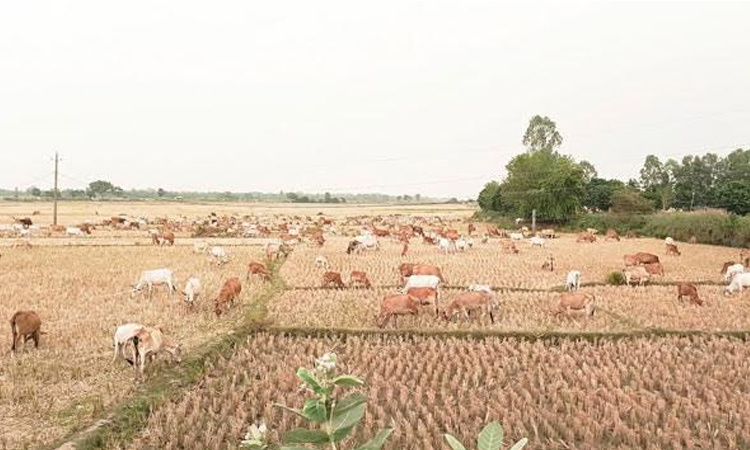News Flash

By Md Aynal Haque
RAJSHAHI, May 18, 2025 (BSS) - Mobile cattle farming has been contributing a lot to ensure protein intake of people in the remote and hard-to-reach communities in the region, including its Barind tract.
Mobile cattle farming, where farmers move their livestock in different locations is not a common practice in the region. The practice has become rare due to shrinking of grazing land.
The present focus is on traditional cattle farming, including beef fattening and rearing for Eid-ul-Azha as many families engaging in commercial rearing and fattening of bulls.
Conventionally, the Livestock Department focuses on farm management, expansion, and inspection of meat processors.
Rafiqul Islam, 63, hailed from Ranihati village under Shibganj Upazila, has brought his cattle flock to Beel Kumary Beel under Tanore Upazila in Rajshahi
Having around 400 big and small cattle and eight people to rear, Islam moves from one upazila to another where vacant lands are available to make sure his domestic animals to graze and survive.
Talking to BSS on Saturday, Rafiqul Islam said fields are their residents from where they collect milk and sell for those to meet up the family needs.
He rears around 50 cattle on an average annually and fattens those naturally.
"I've a target to sell at least 15 cattle in the Bangla month Bhadra every year," he added. Cattle become healthy yielding cherished prices in Bhadra.
Rafiqul remains engaged in the profession for long. Like him, many others are doing the business at present.
Their movement depends on availability of grazing fields of cattle, Islam said, adding that they used to stay 15-20 days in one location on an average.
Every month, he sells milk to the selected milkmen worth around Taka 40,000 together with selling 15-20 cattle worth around Taka 6-7 lakh annually.
Normally, he rears local species of cattle which are disease-resistant and adaptive to the local environment easily.
Meanwhile, poor and marginalised people, including women, have achieved tremendous successes in the field of rearing and fattening cattle, getting various assistances from the government and development partners in both rural and urban areas.
Artificial insemination of cows is gaining popularity in the region following significant achievements in improving the breeding system.
Abdur Razzaque, 45, a farmer of Charghat upazila, has been fattening eight cattle for around seven months aimed at selling those in the upcoming sacrificial animal markets.
Due to the crossbreeding, the cows are giving milk 10 times more than the previous record, said Arafat Hossain, a successful dairy farmer in the city.
He said the producers have adopted new and improved practices and technologies in bull rearing and fattening, contributing to enhanced production and productivity.
The size of the market has expanded due to the growing active role of large and small-scale private companies.
Line agencies have become proactive towards supporting market actors, especially local service providers, by dint of their complementary roles in extension services.
In practice, the LSPs provide training, advice and input to the producers and earn, on average, Taka 5,500 per month. Routinely, they extend different modern technology to the producers by setting demonstration plots in the locality.
Besides, they organise community meetings with the help of private companies for building awareness about quality inputs.
Service contracts were established to provide regular necessary services and inputs to the farmers.
As a result of house-to-house cattle, goat and sheep rearing practices, the Rajshahi division has become home to surplus sacrificial animals, counting to around 1.67 lakh compared to its demand.
In the region, sacrificial animals, primarily cattle, including calves, bulls, buffaloes, goats, and sheep, are commonly sacrificed for Eid-ul-Azha.
Cattle and goat rearing is widespread in the region, resulting in a large supply of sacrificial animals.
According to the latest official data, there are 43.44 lakh sacrificial animals in the division consisting of eight districts this year.
Dr Antim Kumar Sarker, divisional director of the Department of Livestock Services, told BSS that 302 hats consisting of 161 permanent and 141 makeshift ones were fixed for selling and purchasing sacrificial animals in the division.
All the hats will be supervised by medical teams.
In each of the hats, hygiene management will be ensured. To this end, 213 veterinary medical teams were formed.
He said mobile veterinary clinics will remain in each of the cattle markets for sacrificial animals as they will set up the clinics, where veterinary surgeons will remain and provide necessary treatment.